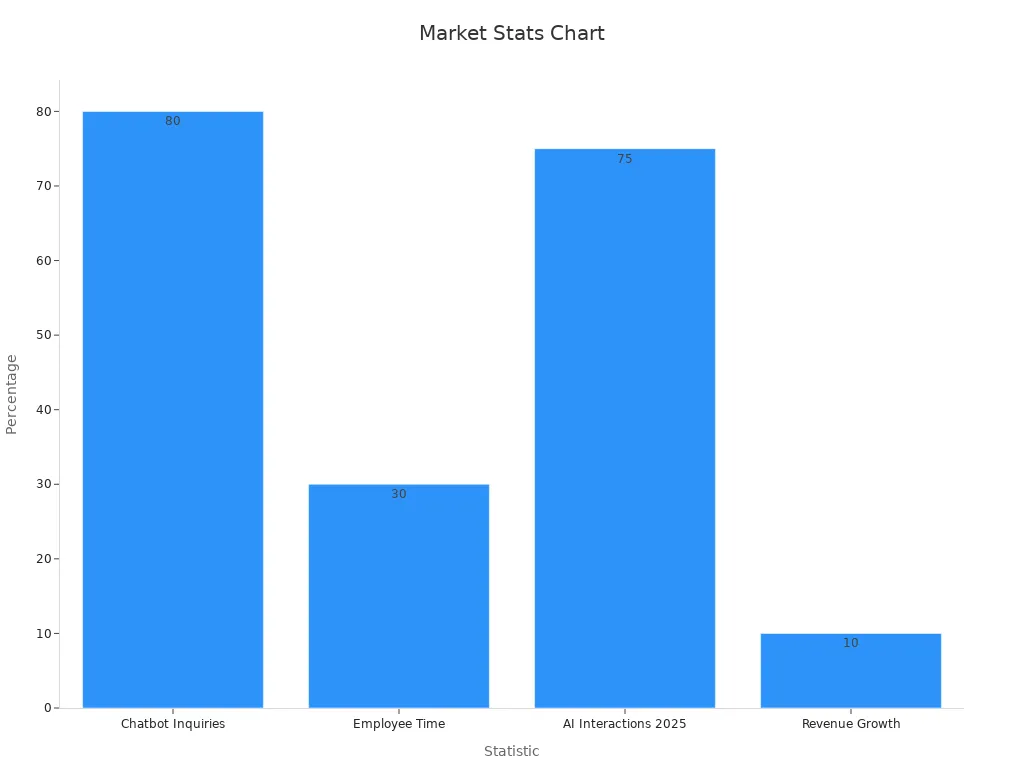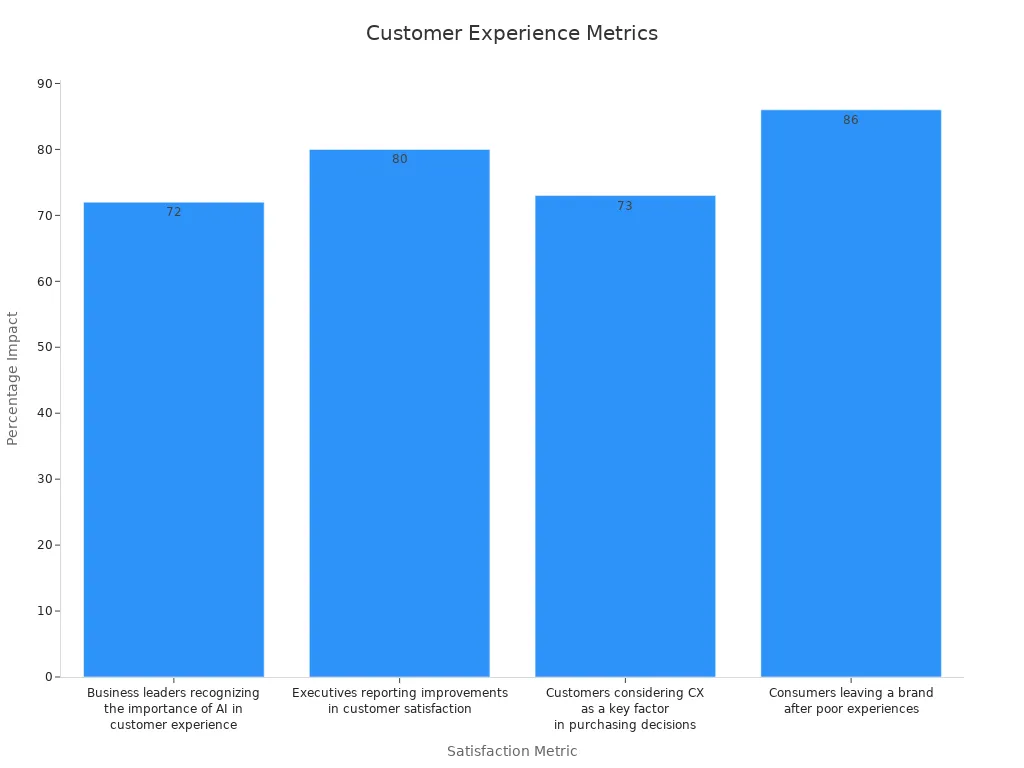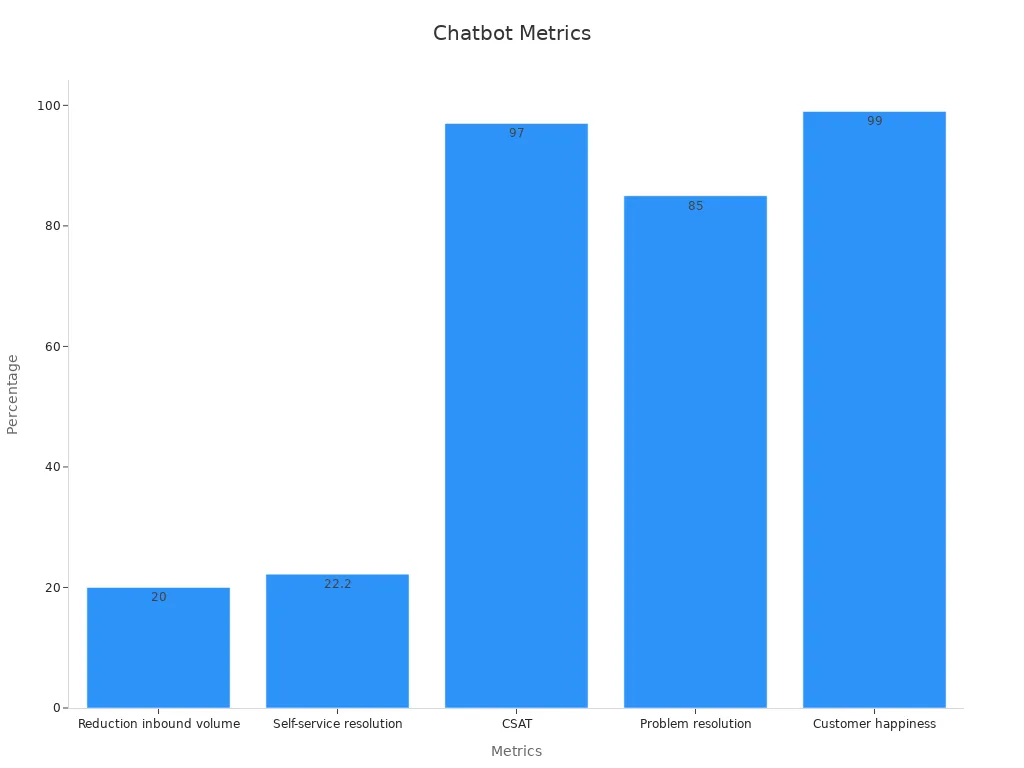How to Transform Customer Support with Automation

Automation is transforming customer support by streamlining processes and delivering faster resolutions. You can now scale operations effortlessly while maintaining high-quality service. For instance, 80% of companies plan to adopt AI chatbots by 2025, and businesses using automation report up to 30% cost savings. This shift not only reduces operational expenses but also enhances customer satisfaction. Research shows that 62% of consumers prefer bots over waiting for human agents. Tools like Sobot demonstrate how to automate customer support effectively, ensuring seamless interactions and improved efficiency.
What is Customer Support Automation?
Definition and Overview
Customer support automation refers to the use of technology to streamline and enhance customer service processes. It involves tools like AI chatbots, automated ticketing systems, and self-service portals that handle repetitive tasks, allowing your team to focus on complex issues. By automating routine interactions, you can provide faster responses, reduce operational costs, and improve customer satisfaction.
Automation is no longer a luxury but a necessity in today’s fast-paced business environment. According to recent statistics:
| Statistic Description | Value | Source |
|---|---|---|
| Percentage of inquiries handled by AI chatbots | 80% | Imaginovation |
| Time saved for employees due to automation | 30% | Imaginovation |
| Predicted percentage of customer interactions powered by AI by 2025 | 75% | Imaginovation |
| Average revenue growth reported by businesses using automation | 10% | Imaginovation |

Key Features of Customer Support Automation
Customer support automation offers several features that enhance efficiency and customer experience:
- Multichannel support: Engage with customers across platforms like email, chat, and social media.
- Organizing by priority: Ensure urgent issues, such as payment disputes, are addressed promptly.
- Email templates: Speed up responses by using pre-designed templates for common queries.
- Self-service options: Empower customers to find answers independently through knowledge bases or FAQs.
These features not only improve response times but also help your team manage workloads effectively. For example, prioritizing tickets ensures critical issues are resolved faster, while email templates allow agents to handle multiple requests efficiently.
Technologies Used in Automating Customer Service

The backbone of customer support automation lies in advanced technologies. AI-powered chatbots, like Sobot’s AI Chatbot, use natural language processing to understand and respond to customer queries. Automated ticketing systems categorize and assign issues to the right agents. Sentiment analysis tools gauge customer emotions, enabling you to tailor responses.
Self-service portals and knowledge bases provide customers with instant access to information. These technologies work together to create a seamless and efficient support experience. By leveraging them, you can reduce costs, improve productivity, and enhance customer satisfaction.
Benefits of Customer Support Automation

24/7 Availability and Scalability
Automating customer service ensures your business operates around the clock. Tools like AI chatbots handle inquiries at any time, providing instant responses even during off-hours. This availability improves customer satisfaction by addressing issues without delay. For example, automation tools can manage after-hours service, ensuring customers in different time zones receive real-time support.
Scalability is another significant advantage. Automation allows you to expand your customer support operations without increasing costs or resources. Whether your business experiences seasonal spikes or rapid growth, automated systems adapt seamlessly. The table below highlights key benefits:
| Benefit | Description |
|---|---|
| 24/7 Availability | Automation tools operate continuously, handling customer inquiries at any time, enhancing satisfaction. |
| Scalability | Businesses can expand support capabilities without a proportional increase in resources or costs. |
| Omnichannel Support | Consistent, high-quality support across various platforms, crucial for customer retention. |
| Personalized Experience | AI tools tailor interactions based on customer preferences, boosting loyalty. |
| After-Hours Service | Automated tools provide real-time solutions regardless of time zones, ensuring customer support. |
| Efficient Scaling | Automation allows for scaling customer support operations without increasing costs or resources. |
Cost Savings and Operational Efficiency
Automating customer service significantly reduces operational costs. By handling repetitive tasks, automation minimizes the need for additional agents. For instance, automating processes can cut costs by up to 40%. It also speeds up resolution times, allowing agents to focus on complex issues.
Here are some financial benefits:
- Average cost to process an invoice manually: $12 to $30.
- Cost after automation: $3 to $6 per invoice.
- Savings per invoice: $9 to $24 (75%-80% reduction).
Additionally, automation enhances efficiency by reducing agent workloads. This enables your team to deliver more personalized service, improving overall productivity. Businesses using automation report saving thousands of hours monthly, which translates into significant cost reductions.
Enhanced Customer Experience and Satisfaction
Customer support automation elevates the customer experience by providing faster and more accurate responses. Self-service options, such as knowledge bases, empower customers to find answers independently. This reduces wait times and enhances satisfaction.
Research shows that 72% of business leaders recognize AI's importance in improving customer experience. Moreover, 80% of executives report increased customer satisfaction after implementing automation. The chart below illustrates the impact of automation on customer satisfaction metrics:

By automating customer service, you can also build loyalty. Over 66% of customers say their loyalty depends on the quality of their experience. Automation ensures consistent, high-quality interactions, making it a valuable tool for retaining customers.
Improved Productivity for Support Teams
Automating customer service significantly boosts the productivity of your support teams. By handling repetitive tasks, automation allows your agents to focus on more complex and meaningful customer interactions. This shift not only improves efficiency but also enhances the quality of service your team delivers.
One of the key ways automation helps is by reducing the time spent on routine inquiries. Tools like AI chatbots can instantly respond to common questions, such as order statuses or account updates. This means your agents no longer need to spend hours answering the same queries repeatedly. Instead, they can dedicate their time to solving unique problems that require human expertise.
Automation also streamlines workflows. For example, automated ticketing systems categorize and assign tickets to the right agents based on priority or expertise. This ensures that no issue gets overlooked and that customers receive timely responses. Additionally, automation tools provide real-time insights into team performance, helping you identify areas for improvement and optimize processes.
Another advantage of automated customer support is its ability to reduce burnout among your team members. By taking over mundane tasks, automation lightens the workload, allowing your agents to focus on tasks that are more engaging and rewarding. This leads to higher job satisfaction and better overall performance.
Incorporating automation into your customer service strategy creates a win-win situation. Your team becomes more productive, and your customers enjoy faster, more efficient support. By leveraging automation, you can transform your support operations into a well-oiled machine that delivers exceptional results.
Challenges in Automating Customer Service
Balancing Automation with Human Interaction
Automating customer service can improve efficiency, but it also presents challenges in maintaining a human touch. Customers often expect empathy and understanding, which automated systems may struggle to provide. For example, AI-driven systems can handle more conversational turns and questions than humans. However, they often fail to probe deeply during open-ended responses.
- AI-driven telephone survey system metrics:
- Average conversational turns: 26.94 (AI) vs. 26.01 (Human)
- Average total sentences: 51.29 (AI) vs. 22.92 (Human)
- Average questions asked: 19.14 (AI) vs. 2.05 (Human)
- Average words per turn: 23.35 (AI) vs. 5.59 (Human)
While automation performs well in structured interactions, it may not match the depth of human engagement. To address this, you should combine automation with human support. This ensures customers receive both quick resolutions and personalized care.
Addressing Privacy and Data Security Concerns
Privacy and data security remain critical concerns when automating customer service. Customers want to know how their data is being used and protected. A recent study revealed that 91% of organizations feel the need to reassure customers about AI-related data usage.
| Statistic | Source |
|---|---|
| 91% of organizations say they need to do more to reassure customers about how their data is being used with AI. | Cisco |
To build trust, you should prioritize transparency. Inform customers about data collection practices and implement robust security measures. This approach not only protects sensitive information but also strengthens customer confidence in your automated systems.
Overcoming Implementation Hurdles
Implementing automation comes with its own set of challenges. Designing systems that understand human language can be complex. Issues like polysemy, homonyms, and synonyms often lead to misunderstandings in chatbot responses.
| Challenge | Description |
|---|---|
| Data Ambiguities | Issues such as polysemy, homonyms, and synonyms can lead to misunderstandings in chatbot responses. |
| Complexity of Human Language | The evolving nature of language complicates the design of NLP systems, affecting human-computer interaction. |
To overcome these hurdles, you should invest in advanced natural language processing (NLP) technologies. Regular updates and testing can also help refine automated systems, ensuring they adapt to evolving customer needs.
Tools and Technologies for Customer Support Automation

AI-Powered Chatbots like Sobot Chatbot
AI chatbots are revolutionizing customer support by handling inquiries efficiently and accurately. These tools use natural language processing to understand customer queries and provide instant responses. For example, Sobot’s AI-powered chatbot operates 24/7, offering multilingual support and resolving common issues autonomously. This reduces inbound discussion volume by 20% and achieves a customer satisfaction score of 97%.
Businesses across industries are adopting AI chatbots to enhance customer interactions. In retail, they provide personalized recommendations and manage feedback. In IT, they assist with troubleshooting and technical support. The customer service automation market is growing rapidly, with a projected CAGR of 20.3% from 2020 to 2027, driven by the demand for AI technologies.

By integrating AI chatbots like Sobot’s, you can improve resolution rates, boost customer happiness, and reduce operational costs.
Automated Ticketing Systems
Automated ticket systems streamline issue management by categorizing and assigning tickets to the right agents. These systems improve response times and ensure no query goes unanswered. Metrics like first response time, average resolution time, and SLA compliance rate highlight their effectiveness. For instance, automated ticket routing assigns requests based on predefined criteria, reducing escalation rates and improving resolution rates.
Sobot’s ticketing system enhances efficiency by automating workflows and managing SLAs. It integrates seamlessly with other tools, ensuring a unified workspace for agents. This reduces ticket backlog and improves customer satisfaction. Businesses using automated ticket systems report significant improvements in productivity and faster issue resolution.
| Metric | Description |
|---|---|
| First Response Time | Average time taken for a first response from an agent on a ticket. |
| SLA Compliance Rate | Percentage of tickets resolved within agreed-upon SLA timeframes. |
| Resolution Rate | Percentage of tickets resolved across channels at a given time. |
Self-Service Portals and Knowledge Bases
Self-service portals empower customers to find answers independently, saving time for both customers and agents. Studies show that 60% of customers prefer self-service tools for simple tasks, and businesses adopting these solutions see a 45% increase in customer satisfaction. Sobot’s knowledge base allows you to create searchable content from articles, PDFs, and FAQs, making it easier for customers to resolve issues on their own.
These tools also provide valuable insights through search analytics and feedback analysis. For example, identifying frequently searched topics helps you optimize your content. By offering self-service options, you can reduce ticket volume and improve first-contact resolution rates, ensuring a seamless customer experience.
Sentiment Analysis and Predictive Tools
Sentiment analysis and predictive tools are transforming customer service automation by providing deeper insights into customer emotions and behaviors. These technologies analyze text, voice, and social media interactions to determine customer sentiment. By understanding whether a customer feels satisfied, frustrated, or neutral, you can tailor your responses and improve their experience.
One of the most significant advantages of sentiment analysis is its ability to prevent negative experiences. For instance, identifying dissatisfaction early allows you to address issues before they escalate. Predictive tools take this a step further by forecasting customer behavior based on sentiment trends. This helps you anticipate needs and deliver proactive solutions. Together, these tools empower you to create a more personalized and engaging customer journey.
Here’s how sentiment analysis and predictive tools benefit customer service automation:
| Benefit | Description |
|---|---|
| Improve Customer Experience | Engaging with customers based on positive sentiment to enhance products or services. |
| Prevent Negative Experiences | Identifying and addressing potential issues before they escalate, improving overall satisfaction. |
| Monitor Brand Reputation | Tracking customer sentiments on social media to maintain a positive brand image and prevent crises. |
| Predict Customer Behavior | Analyzing sentiment trends to forecast future behaviors, aiding in marketing and product development. |
| Integration with Service Tools | Enhancing existing customer service systems with sentiment insights for personalized and proactive service. |
For example, chatbots and virtual assistants equipped with sentiment analysis can adjust their tone and responses based on customer emotions. If a customer expresses frustration, the chatbot can escalate the issue to a human agent for immediate resolution. This seamless integration ensures that your customers feel heard and valued.
Predictive tools also play a crucial role in optimizing your operations. By analyzing historical data, they help you allocate resources effectively during peak times. This reduces wait times and enhances overall efficiency. When combined with chatbots and virtual assistants, these tools create a powerful system that delivers exceptional customer support.
By leveraging sentiment analysis and predictive tools, you can not only improve customer satisfaction but also strengthen your brand reputation. These technologies enable you to stay ahead of customer expectations, ensuring a competitive edge in today’s fast-paced market.
How to Automate Customer Support Effectively
Identifying Areas Suitable for Automation
To begin automating customer service, you must identify processes that benefit most from automation. Focus on tasks that are repetitive, high-volume, or prone to human error. For example, answering frequently asked questions or processing routine requests like order tracking are ideal candidates. These tasks not only consume time but also reduce the efficiency of your support team.
Use specific criteria to determine suitability for automation. Processes with high standardization and scalability potential often yield the best results. For instance, automating repetitive tasks like data entry minimizes errors and improves efficiency. The table below highlights key criteria for identifying automation opportunities:
| Criteria | Description |
|---|---|
| Repetitiveness | Tasks performed repeatedly, such as FAQs or order updates. |
| Volume | High-frequency tasks that require significant manual effort. |
| Error-proneness | Processes where human errors can lead to inefficiencies or inaccuracies. |
| Standardization Potential | Tasks with consistent steps and predictable outcomes. |
| Scalability | Processes that can grow with your business needs. |
By focusing on these areas, you can take the first steps to automate customer service effectively.
Selecting the Right Tools and Solutions
Choosing the right automation tools is crucial for success. Look for solutions that align with your business needs and integrate seamlessly with existing systems. For example, tools like Sobot’s AI-powered chatbot offer multilingual support and self-service options, making them ideal for businesses of all sizes.
When evaluating tools, consider factors like scalability, ease of use, and security. A user-friendly interface ensures your team can adopt the tool quickly. Scalability allows the solution to grow with your business, while robust security safeguards protect customer data. The table below outlines essential factors to consider:
| Factor | What to Consider |
|---|---|
| Scalability | Can the tool handle growing data and user demands? |
| Integrations | Does it connect with your CRM or ERP systems? |
| Customizability | Can you tailor it to meet your team’s specific needs? |
| Ease of Use | Is the interface intuitive for non-technical users? |
| Security | Does it include encryption and compliance features to protect sensitive data? |
Selecting the right tools ensures a smooth transition to automation and maximizes its benefits.
Training Teams for Automation Integration
Training your team is a critical step in automating customer service. Employees must understand how to use automation tools effectively to achieve desired outcomes. Start by providing hands-on training sessions that cover tool functionalities and best practices. For example, teach agents how to manage automated ticketing systems or monitor chatbot performance.
Measure the impact of training using metrics like knowledge retention and task completion rates. A well-trained team not only adapts quickly but also enhances productivity. The table below illustrates key performance indicators for training success:
| Level/Metric | Description |
|---|---|
| Reaction | Measures participants’ immediate feedback on the training. |
| Learning | Assesses knowledge gained during the training sessions. |
| Behavior | Observes how employees apply new skills in their daily tasks. |
| Results | Evaluates the overall impact on productivity and efficiency. |
| ROI | Compares financial benefits against the cost of training. |
Investing in training ensures your team can fully leverage automation tools, leading to improved customer support and operational efficiency.
Monitoring and Optimizing Automated Processes
Once you implement automation, monitoring and optimizing the processes becomes essential. This ensures your systems perform efficiently and deliver the desired results. Regular monitoring helps you identify bottlenecks, errors, or areas needing improvement. Optimization, on the other hand, fine-tunes these processes to maximize their potential.
Start by tracking key performance indicators (KPIs) to measure the effectiveness of your automated systems. These metrics provide valuable insights into how well your automation is working. For example, you can evaluate whether automation has reduced errors or improved productivity. Below is a table highlighting important KPIs to monitor:
| Metric | Description |
|---|---|
| Cycle Time Reduction | Measures the speed of processes post-automation compared to pre-automation. |
| Error Reductions | Indicates the accuracy of processes after automation, leading to fewer manual interventions. |
| Quality Output | Assesses if the output meets expected quality levels, enhancing reliability on automation. |
| Better Productivity | Evaluates productivity through cycle time, resource utilization, and task completion rates. |
| Motivated Staff | Reflects employee satisfaction and motivation, impacting overall productivity and quality. |
| ROI / Cost Reduction | Measures the financial return on investment and cost savings achieved through automation. |
To optimize your automated processes, analyze these metrics regularly. For instance, if error rates remain high, review the system's logic or data inputs. If productivity lags, consider adjusting workflows or reallocating resources. Small adjustments can lead to significant improvements over time.
You should also gather feedback from your team. Employees interacting with automated tools daily can provide insights into inefficiencies or challenges. Use this feedback to refine your systems and ensure they align with your business goals.
By monitoring and optimizing your automated processes, you can maintain peak performance and adapt to changing needs. This proactive approach ensures your automation strategy continues to deliver value over the long term.
Best Practices for Customer Support Automation
Focusing on Customer Needs and Expectations
To succeed with customer support automation, you must prioritize customer needs and expectations. Automation tools can enhance communication by providing timely updates, such as informing customers about the status of their orders or repairs. This keeps them engaged and reduces frustration. Additionally, structuring escalations and decisions within automated workflows ensures personalized resolutions without long delays.
Meeting customer expectations also drives loyalty and revenue. Studies show that 92% of businesses focusing on customer experience report increased loyalty, while 84% see higher revenue. Furthermore, 42% of consumers are willing to pay more for better experiences. Ignoring these expectations can lead to dissatisfaction, with one-third of customers abandoning brands after a single bad experience. By aligning automation with customer priorities, you can deliver consistent and positive interactions.
Balancing Automation with Human Support
Automation tools excel at handling repetitive tasks, but human support remains essential for complex or emotional issues. Customers value empathy and personalized solutions, which only human agents can provide. For example, empathetic communication significantly enhances satisfaction, as shown in studies by the Journal of Business Research. Some customers even prefer human interaction for simple issues, highlighting the importance of maintaining a personal connection.
Combining automation with human support creates a balanced approach. Automation reduces agent workloads, allowing them to focus on meaningful interactions. This mix improves efficiency, trust, and overall satisfaction. A table below highlights the benefits of this balance:
| Benefit | Description |
|---|---|
| Individualized solutions | Humans provide personalized support that automation cannot achieve. |
| Trust and loyalty | Human agents build stronger relationships with customers. |
| Efficient customer support | Automation handles routine tasks, while agents focus on complex issues. |
| Improved customer satisfaction | Access to both automation and human support enhances experiences. |
Continuously Optimizing Automated Workflows
Automation workflows require regular optimization to maintain effectiveness. Start by identifying workflow components, such as tasks and tools, and use visualizations like flowcharts to spot inefficiencies. Automating routine tasks saves time and reduces errors, while monitoring workflows ensures they adapt to changing needs.
Optimized workflows offer several benefits. They improve quality by reducing errors and enhance employee satisfaction by minimizing frustration. Better resource management and faster outputs lead to higher customer satisfaction. For example, advanced tools improve data accuracy, aiding decision-making and ensuring compliance. Regular adjustments keep your automation competitive and aligned with business goals.
To optimize workflows effectively, follow these steps:
- Identify all tasks, stakeholders, and tools involved.
- Create visual representations to find inefficiencies.
- Focus on smooth transitions between departments.
- Automate repetitive tasks to save time.
- Monitor and adjust workflows based on performance data.
By continuously refining your processes, you can maximize the benefits of automation and deliver exceptional customer support.
Leveraging Sobot’s Omnichannel Solutions for Seamless Integration
Sobot’s omnichannel solutions simplify customer support by unifying communication across multiple platforms. These solutions allow you to manage interactions from email, social media, live chat, and voice calls in one centralized workspace. This integration ensures consistent service quality, regardless of the channel your customers prefer.
For example, Sobot’s unified workspace consolidates customer data, enabling your team to provide personalized responses. Imagine a customer reaching out via WhatsApp about a delayed order and later following up through email. With Sobot, your agents can access the entire conversation history in one place. This eliminates the need for customers to repeat themselves, improving their experience.
Sobot’s omnichannel platform also enhances efficiency. By automating repetitive tasks, such as ticket categorization and routing, it reduces agent workload. This allows your team to focus on resolving complex issues. Businesses using Sobot report a 30% boost in productivity and faster response times.
Another key feature is the integration of AI-powered tools like chatbots. These tools handle routine inquiries, such as order tracking or FAQs, 24/7. This ensures your customers receive instant support, even outside business hours. Additionally, Sobot’s analytics provide insights into customer behavior and team performance. These insights help you optimize your processes and improve satisfaction rates.
By leveraging Sobot’s omnichannel solutions, you can streamline operations and deliver seamless support. These customer service tools not only enhance efficiency but also build trust and loyalty. To learn more, visit Sobot’s Omnichannel Solutions.
Customer support automation has the power to revolutionize how you interact with customers. It improves efficiency, reduces costs, and enhances satisfaction. The table below highlights its transformative potential:
| Statistic | Outcome |
|---|---|
| 73% of shoppers believe AI could improve their customer experience | Customers prefer AI for faster, more accurate interactions. |
| 80% of customers had a positive experience with AI software | AI boosts satisfaction and loyalty. |
| Customer satisfaction can increase by up to 20% with positive AI interactions | AI delivers measurable improvements in service quality. |
| Companies with excellent customer experience grow revenues 4%-8% faster | Automation drives financial growth. |
By adopting tools like Sobot Chatbot, you can automate routine tasks, provide 24/7 support, and personalize interactions. Start transforming your customer service today to stay ahead in a competitive market.
FAQ
What is the role of automation in customer service?
Automation in customer service simplifies repetitive tasks like answering FAQs or routing tickets. It ensures faster responses and reduces errors. By using tools like chatbots, you can provide consistent support while freeing your team to focus on complex issues.
How do automated tools improve personalized customer service?
Automated tools analyze customer data to tailor responses and recommendations. For example, chatbots can use past interactions to offer relevant solutions. This approach enhances personalized customer service, making customers feel valued and understood.
Can automation handle multiple support channels effectively?
Yes, automation integrates various support channels like email, chat, and social media into one platform. This ensures consistent communication and faster resolutions. Tools like Sobot’s omnichannel solutions unify these channels, improving efficiency and customer satisfaction.
Is automation suitable for small businesses?
Automation benefits businesses of all sizes. Small businesses can use it to handle high volumes of inquiries without hiring additional staff. It also helps maintain quality service as your business grows.
How does automation impact customer satisfaction?
Automation improves customer satisfaction by providing quick and accurate responses. Self-service options like knowledge bases empower customers to resolve issues independently. This reduces wait times and enhances their overall experience.
See Also
Transforming Customer Support With AI-Powered Agents
Excelling In Customer Support Through Live Chat Techniques
Enhancing SaaS Customer Service Using Live Chat Approaches
Increasing Operational Efficiency With AI Customer Service Tools